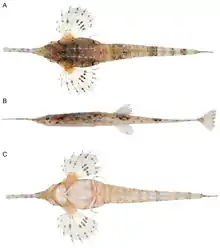Pegasus tetrabelos
Pegasus tetrabelos is a species of coastal sea moth which occurs over muddy and sandy substrates in seas off northeastern Australia. It was described in 2016, separated from the more widespread and sympatric P. volitans.[2]
| Pegasus tetrabelos | |
|---|---|
 | |
| Holotype | |
| Scientific classification | |
| Domain: | Eukaryota |
| Kingdom: | Animalia |
| Phylum: | Chordata |
| Class: | Actinopterygii |
| Order: | Syngnathiformes |
| Family: | Pegasidae |
| Genus: | Pegasus |
| Species: | P. tetrabelos |
| Binomial name | |
| Pegasus tetrabelos | |
There have been no devoted surveys or population approximations for this particular species. The species is described from 135 specimens that were gathered in scientific trawl surveys between 2003 and 2005.[2]
Habitat and Ecology
Pegasus tetrabelos dwells in sandy substrates at depths ranging from 8 to 40 m.[2] Little is known about their feeding habits, but other members of the family tend to forage on small epifaunal invertebrates like crustaceans. [3]
Threats
The species is caught as bycatch in shrimp trawl fisheries.[2] Nothing is known about trade in this particular species, but substantial target and bycatch fisheries for pegasids occur throughout the Indo-West Pacific for traditional medicine and aquarium use.[4][5]
References
- Pollom, R. (2017). "Pegasus tetrabelos". The IUCN Red List of Threatened Species. 2017: e.T101730582A103209434. doi:10.2305/IUCN.UK.2017-3.RLTS.T101730582A103209434.en.
- Deborah Osterhage; John J. Pogonoski; Sharon A. Appleyard & William T. White (2016). "Integrated Taxonomy Reveals Hidden Diversity in Northern Australian Fishes: A New Species of Seamoth (Genus Pegasus)". PLOS ONE. 11 (3): e0149415. Bibcode:2016PLoSO..1149415O. doi:10.1371/journal.pone.0149415. PMC 4774964. PMID 26934529.
- Herold, D. & Clark, E. (1993). "Monogamy, spawning and skin-shedding of the sea moth, Eurypegasus draconis (Pisces: Pegasidae)". Environmental Biology of Fishes. 37 (3): 219–236. doi:10.1007/BF00004630. S2CID 23104364.
- Amanda C. J. Vincent (1997). "Trade in pegasid fishes (sea moths), primarily for traditional Chinese medicine" (PDF). Oryx. 31 (3): 199–208. doi:10.1046/j.1365-3008.1997.d01-12.x.
- Marivic G. Pajaro; Jessica J.Meeuwig; Brian G. Giles & Amanda C.J. Vincent (2004). "Biology, fishery and trade of sea moths (Pisces:Pegasidae) in the central Philippines" (PDF). Oryx. 38 (4): 432–438. doi:10.1017/s003060530400081x.
Palsson, W.A. and Pietsch, T.W. 1989. Revision of the acanthopterygian fish family Pegasidae (order Gasterosteiformes). Indo-Pacific Fishes 18: 1038.
